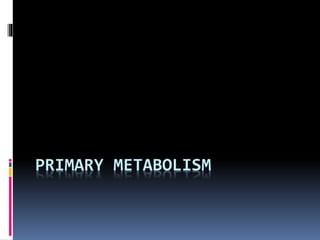
Primary metabolism of Fungi
- 3. FUNCTIONS OF METABOLISM ANABOLIC • Change nutrients into structural and functional components of the organism CATABOLIC • Extract chemical energy or nutrient element such as N and S from complex nutrients to provide E and materials for anabolic reactions
- 4. Anabolism depends on catabolism for E in the form of NADH,ATP and NADPH. Also for the production of key intermediates for functional macromolecules synthesis
- 5. Primary Metabolism The metabolic events that are important to functions of fungus in pure culture
- 6. Secondary metabolism coextensive with primary metabolism The division into primary and secondary depends on the distribution of the metabolites among the organisms. Eg of metabolites? Organic acid, vitamin, antibiotics etc.
- 7. Carbon and Energy Metabolism Glucose metabolism Non-carbohydrates function as sole sources of C, must be convertable to glucose by a process called gluconeogenesis Provide precursors for cell wall , glycoproteins and other materials derived directly from hexoses.
- 8. Glycolysis Glycolysis: the breakdown of glucose by enzymes, releasing energy and pyruvic acid 3 pathways for hexoses: 1. EM (Embden-Meyerhof-Parnas) 2. HM (Hexose monophosphate ) 3. ED (Entner-Doudoroff)
- 9. Glycolysis of Pentoses 2 pathways: 1. XP (xylitol pathway) 2. PK (phosphoketolase pathway) EM, HM and XP pathways are universal in fungi PK widespread among yeasts ED – only for Tilletia caries and Caldariomyces fumago
- 11. Although EM and HM pathways lead through G3P to pyruvate but different metabolic functions. EM uses NAD as electron acceptor. HM leads to the reduction of NADP to NADPH. There are other sources of reduced NADP for biosynthetic purposes besides HM pathway.
- 12. Fermentation Regeneration of NAD by the transfer of electrons from NADH to an organic electron acceptor generated by the metabolism of the foodstuff. In fungi this electron acceptor is pyruvate
- 13. Types of Fermentation 1. Alcoholic 2. Lactic acid 3. Mixed acid fermentation Pyruvic acid as electron acceptor
- 14. ALCOHOLIC FERMENTATION Pyruvate to ethanol and CO2 Saccharomyces Aspergillus, Fusarium and Mucor are well known for this ability but obligate aerobes.
- 15. LACTIC ACID FERMENTATION Found primarily in Chytridomycetes, Oomycetes and Zygomycetes Rhizopus, a member of Zygomycete, carry out lactic acid fermentation together with alcoholic fermentation.
- 16. Mixed Acid Fermentation Found in a small group of Chytridiomycetes Similar to mixed acid fermentation of Enterobacteriaceae with acetate, lactate, formate, ethanol, methane, CO2 and H2 as end products.
- 17. RESPIRATION In fungi is similar to that in other organisms. 3 interdependent processes 1. Citric acid cycle 2. Electron transport 3. Oxidative phosphorylation Mitochondrion: center of respiration
- 18. TCA is a central hub of both catabolic and anabolic metabolism. • ETC – 2nd critical process in respiration
- 19. ALTERNATIVE RESPIRATION 2 alternate pathways of electron transport that are distinct from the cytochrome path. Differ from the cytochrome path in being insensitive to cyanide and sensitive to either salycil hydroxamate (SHAM) or azide.
- 20. • SHAM-sensitive pathway accepts electrons as the level of ubiquinol and transports them to O2 without proton transport Without phosphorylation of ADP. Azide-sensitive pathway also lack proton transport capability. The alternative pathways are readily demonstrable when the normal pathway is blocked or limited.
- 21. ENERGY METABOLISM OF FUNGI Group Name Respiration Fermentatio n Anaerobic growth Fungi Obligate respirers Yes No No Many yeasts and most filamentous fungi Aerobic respirers Yes Anaerobic in pregrown cells No A few yeasts and filamentous fungi Aerobic fermentors Limited Aerobic and Anaerobic No Schizosaccharomyces pombe and other yeasts Facultative aerobic fermentors Limited Aerobic and Anaerobic Facultative Saccharomyces cerevisiae Obligate anaerobes Absent Anaerobic Obligate Rumen Chytridiomycetes
- 22. OTHER DEGRADATIVE PATHWAYS Serve several functions: 1. Release of NH4 for reutilization 2. Provision of carbon metabolites utilizable as C and E sources 3. Detoxification of inhibitory compounds Example: degradation of amino acids, purines and pyrimidines.
- 23. GLUCONEOGENESIS Required f o r growth on noncarbohydrate carbon sources Involves substrates closely related to the EM pathway and requires the reversal of this process. general property of fungi.
